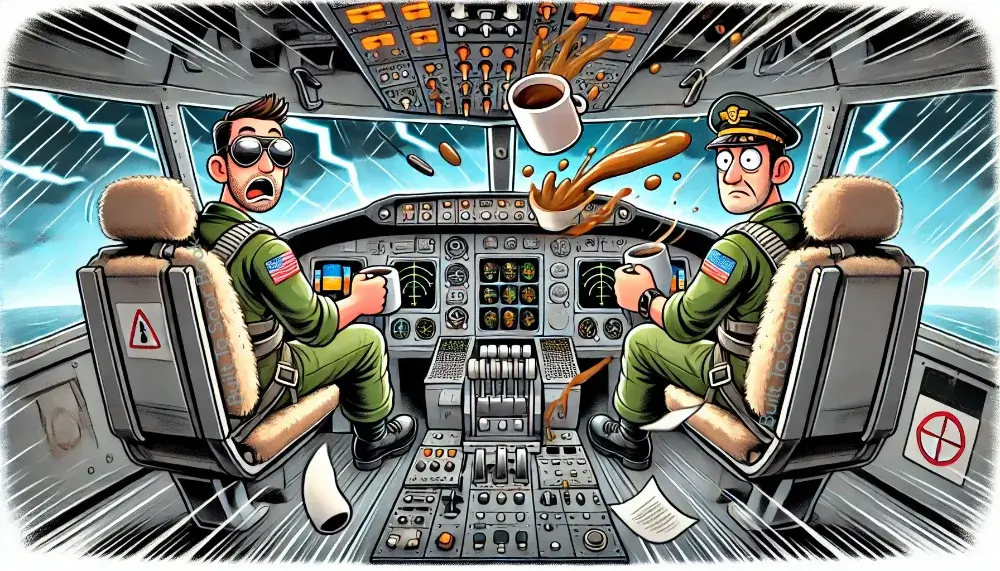As a former Air Force C-5 Galaxy pilot, I’ve experienced firsthand the critical moments when meticulous planning meets unexpected turbulence—like the unforgettable flight from Spain to the Azores.
In business, just as in aviation, leaders must anticipate uncertainty and design their organizations intentionally, ensuring they’re ready to navigate through any storm and emerge stronger on the other side.
The Flight I’ll Never Forget
I’ll never forget the flight from Spain to the Azores. As a C-5 Galaxy pilot, I was accustomed to meticulous planning, precise checklists, and—let’s be honest—pretty smooth rides. After all, the C-5 is massive, heavy, and stable. Turbulence? Usually just a gentle reminder to tighten your seatbelt.
But this particular mission was different. The Azores, a remote island chain in the Atlantic, required extra fuel reserves in case of unexpected weather or runway closures. The forecast called for some rain and wind—nothing unusual. But as we cruised over the ocean, the headwinds intensified, forcing us to burn more fuel than planned. No big deal, right? Just a minor inconvenience.
Then, about 100 miles out, we received news that the crosswinds at our destination were dangerously out of limits. Translation: if we attempted to land, we risked scraping a wing—or worse. Suddenly, our routine flight had become anything but routine.
When Turbulence Strikes Hard
As we approached, the turbulence escalated dramatically. The massive C-5, usually steady as a rock, was now bouncing around like a ping-pong ball in a washing machine. Sweat trickled down my forehead as I gripped the controls, eyes glued to the instruments. Clouds obscured our view, and the runway ahead ended abruptly at the base of a large mountain—just to keep things interesting.
We began our final approach, hoping desperately the winds would calm enough to land safely. Gusts whipped in and out of limits, teasing us with brief windows of opportunity. At the last possible moment, the winds dipped within acceptable limits, and we touched down safely—exhaling collectively for the first time in what felt like hours.
Turbulence in Business: Expect the Unexpected
Reflecting on that flight, I realized how closely it mirrors the unexpected turbulence we face in business. As CEOs and senior leaders, we meticulously plan our strategies, set clear goals, and build strong teams. But inevitably, turbulence strikes—market disruptions, economic downturns, or internal crises. The question isn’t whether turbulence will hit, but how we’ll respond when it does.
Unfortunately, some leaders react to business turbulence like nervous passengers—eyes closed, gripping their armrests, hoping it ends soon. But hope isn’t a strategy. Great leaders, like great pilots, anticipate turbulence and have a clear plan for navigating through it.

Step 1: Quickly Assess the Situation
When unexpected challenges arise, first quickly assess the situation. On our Azores flight, we immediately recalculated fuel reserves, evaluated alternate landing sites, and monitored real-time weather data. Similarly, when your business encounters turbulence, gather accurate information quickly. Understand the scope and scale of the issue before making rash decisions. Panic-driven decisions rarely end well—just ask anyone who’s ever hit “reply all” by mistake.
Step 2: Communicate Clearly and Transparently
Next, communicate clearly and transparently with your team. Imagine if, during our turbulent approach, I’d nervously announced, “Uh, crew, we’re not exactly sure what’s happening, but we’ll get back to you.” Not exactly reassuring, right? Your team feels the same way during business uncertainty. Be honest about what you know, what you don’t, and what you’re doing to address the situation. Clear communication builds trust and reduces anxiety.
Step 3: Prioritize Immediate Actions to Stabilize
Then, prioritize immediate actions to stabilize the situation. Pilots adjust altitude or speed to smooth out the ride. In business, this might mean temporarily reallocating resources, pausing certain initiatives, or doubling down on core strengths. During my time leading business turnarounds within many businesses, decisive, focused action is critical. Don’t try to fix everything at once—focus on stabilizing first, then strategize.
Depending on the level of urgency, sometimes it’s better to break the solution into smaller, bite-sized chunks. This approach makes complex problems easier and faster to develop, deploy, and manage, helping your team achieve quick wins and maintain momentum.
Step 4: Adapt Your Strategy in Real-Time
Once stabilized, adjust your strategy based on real-time feedback. Pilots constantly monitor instruments and adjust their flight path accordingly. Similarly, great leaders remain agile, adapting their plans based on new information. Rigidity is your enemy during turbulence. Flexibility, on the other hand, is your best friend—like that one friend who always has snacks when you’re hungry.
Step 5: Conduct a Post-Event Debrief
Finally, conduct a post-event debrief to learn and improve. After every flight, pilots review what went well and what could be improved. In business, this step is often overlooked, but it’s essential. Gather your team, discuss openly what happened, and identify lessons learned. This practice builds resilience and ensures you’re better prepared for future turbulence.
Turbulence is Inevitable—Panic is Optional
Here’s the bottom line: turbulence is inevitable, but panic is optional. By assessing quickly, communicating clearly, prioritizing decisively, adapting flexibly, and learning continuously, you can navigate any challenge with confidence.
In my upcoming book, Built to Soar, I dive deeper into these principles, sharing practical tools and real-world examples to help you build a business that’s intentionally designed to handle turbulence and achieve sustainable growth.
So, the next time your business hits unexpected bumps, channel your inner pilot. Stay calm, stay focused, and remember—turbulence is temporary, but great leadership leaves a lasting impact.
Now, if you’ll excuse me, I need to refill my coffee. Hopefully, this time it stays in the cup.


